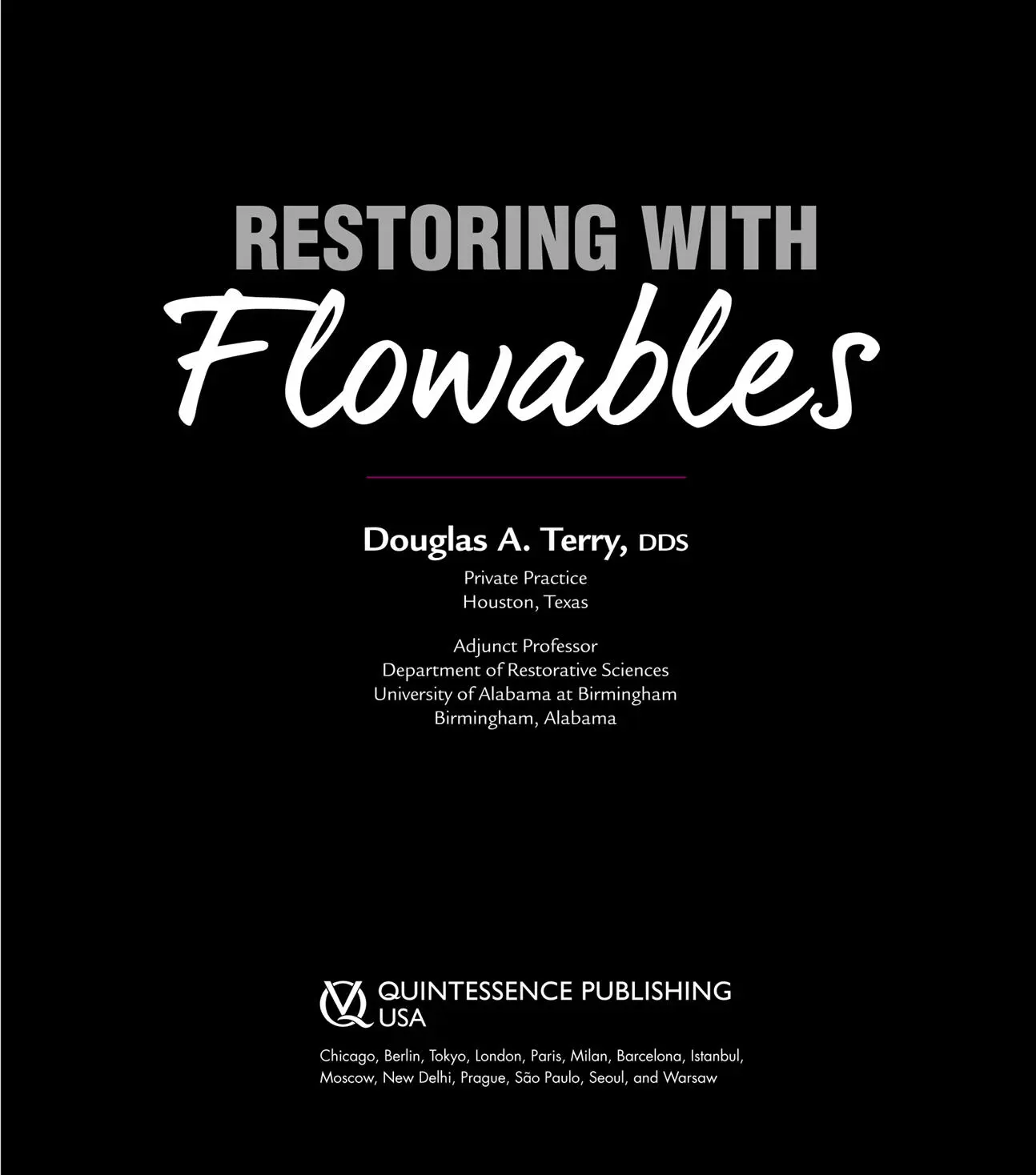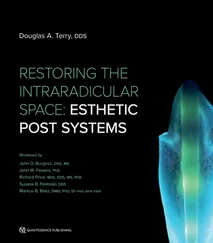Restoring with Flowables

Library of Congress Cataloging-in-Publication Data
Names: Terry, Douglas A., author.
Title: Restoring with flowables / Douglas A. Terry.
Description: Hanover Park, IL : Quintessence Publishing Co, Inc., [2017]
Includes bibliographical references and index.
Identifiers: LCCN 2016035134 (print) | LCCN 2016035775 (ebook) | ISBN 9780867156683 (hardcover) | ISBN 9780867157482 | ISBN 9780867156683 (softcover)
Subjects: | MESH: Resin Cements--therapeutic use |
Nanoparticles--therapeutic use | Composite Resins--therapeutic use
Classification: LCC RK652.5 (print) | LCC RK652.5 (ebook) | NLM WU 190 | DDC 617.6/95--dc23
LC record available at https://lccn.loc.gov/2016035134

©2017 Quintessence Publishing Co, Inc
Quintessence Publishing Co Inc
4350 Chandler Drive
Hanover Park, IL 60133
www.quintpub.com
5 4 3 2 1
All rights reserved. This book or any part thereof may not be reproduced, stored in a retrieval system, or transmitted in any form or by any means, electronic, mechanical, photocopying, or otherwise, without prior written permission of the publisher.
Editor: Leah Huffman
Design/Production: Erica Neumann
Contents
Foreword Foreword “The important thing is not to stop questioning. Curiosity has its own reason for existing… Never lose a holy curiosity.” With these words, Albert Einstein encourages us to use our imagination and intuition to push the boundaries of the commonly accepted and create real progress. For as long as I have known Douglas Terry, he has always followed that mantra, never satisfied with the status quo and continuously elevating dental care to new heights of clinical excellence. This book presents such innovative concepts in a most comprehensive and invigorating manner. The incredible breadth of clinical applications of modern flowable composites, especially in combination with a novel injection technique, is demonstrated in such a compelling manner that it calls into question the validity of many “traditional” treatment concepts and materials. While the existing evidence from a material science standpoint is convincing and supportive of the increased use of flowable composite materials in everyday clinical practice, the clinical simplicity, versatility, and longevity of the techniques described make them a true alternative to conventional protocols and restorative materials. In addition to exceptional clinical documentation, one of the reasons Douglas’s books stand out in the dental literature and are so popular among clinicians and researchers alike is his unique ability to tell a compelling story. You will be drawn into the journey, starting with the fundamentals of adhesive dentistry and flowable composites and finishing with a variety of clinical applications and techniques you probably never even thought about. The level of detail Douglas provides from both scientific and clinical standpoints is astonishing, but it is never overwhelming due to his fluid and captivating writing style that keeps you reading and learning. In this book he has teamed up with the most renowned researchers and clinicians to distill the critical scientific and clinical information into a comprehensible and visually fascinating message. Whether you are a dental student or a most seasoned clinician or scientist, this book will open a new world to you and spur your curiosity in an unprecedented manner. “Never lose a holy curiosity!” Markus B. Blatz, DMD, PhD, Dr med dent habil Professor and Chair, Department of Preventive and Restorative Sciences, Penn Dental Medicine President, International Academy for Adhesive Dentistry
Preface
Contributors
1 Evolution of Flowable Resin Composites
Historical Perspective
Next-Generation Flowable Resin Composites
Restorative Material Selection
Current Developments in Nanotechnology with Resin Composite
Empirical Data
2 An Adhesive Design Concept
Biomaterial Selection
General Considerations for Adhesive Preparation Design
Tooth Preparation for Intracoronal Restorations
Tooth Preparation for Extracoronal Restorations
Adhesion
Priming and Adhesion
Stresses at the Restorative-Tooth Interface
The Light-Curing Unit: Evaluation and Usage (Courtesy of Richard Price, BDS, DDS, MS, PhD)
Placement Procedures and Techniques
Criteria for Improving Adhesion at the Interface
3 Direct Restorative Applications for Flowables
Anterior and Posterior Composite Restorations
• Class I Restoration
• Class II Restoration
• Class III Restoration
• Class V Restoration
• Restoring the Incisal Edge Defect
 Composite Mock-up
Composite Mock-up
Sealants and Preventive Resin Restorations
• Sealants
• Preventive Resin Restorations
Provisional Restorations: Fabrication, Modification, and Repair
• Provisional Restoration Fabrication
• Reline and Repair of Voids or Discrepancies in Acrylic Provisional Crowns Before Cementation
Composite Tooth Splinting
Enhancing Internal Adaptation
Intraoral Repair of Fractured Ceramic Restorations
• Rebonding the Fractured All-Ceramic Crown
• Rebonding the Fractured Metal-Ceramic Fixed Partial Denture
Stabilizing, Securing, and Sealing the Dental Dam Clamp
Bonding Fixed Orthodontic Appliances
• Bonding Orthodontic Brackets
• Bonding a Lingual Orthodontic Retainer
Eliminating Cervical Tooth Sensitivity
• Eliminating Cervical Tooth Sensitivity Prior to Bleaching
• Reducing Stress at the Interface
Creating a Vertical Stop for Interocclusal Records
Repairing Denture Teeth
Sealing Endodontic Access Openings
Immediate Dentin Sealing Technique
Adhesive Reattachment of a Tooth Fragment: The Biologic Restoration
Replicating and Maintaining the Peri-implant Soft Tissue Contours
Developing the Ovate Pontic Site
Maintaining Gingival Position After Connective Tissue Grafting Using the Tunneling Technique with Composite Buttons
Bonding Indirect Restorations Using Flowables at Elevated Temperatures
 • Bonding Porcelain Veneers
• Bonding Porcelain Veneers
• Inlay Cementation
4 Clinical Applications of the Injectable Resin Composite Technique
Class III Composite Restoration
Class IV Resin Composite Restorations
Stratification Layering Technique with Conventional Hybrid Resin Composite
Inverse Injection Layering Technique
Class V Resin Composite Restorations
Occlusal Abfraction Lesions
Bonding a Lingual Orthodontic Retainer
 Orthodontic Space Management
Orthodontic Space Management
Читать дальше



 Composite Mock-up
Composite Mock-up









